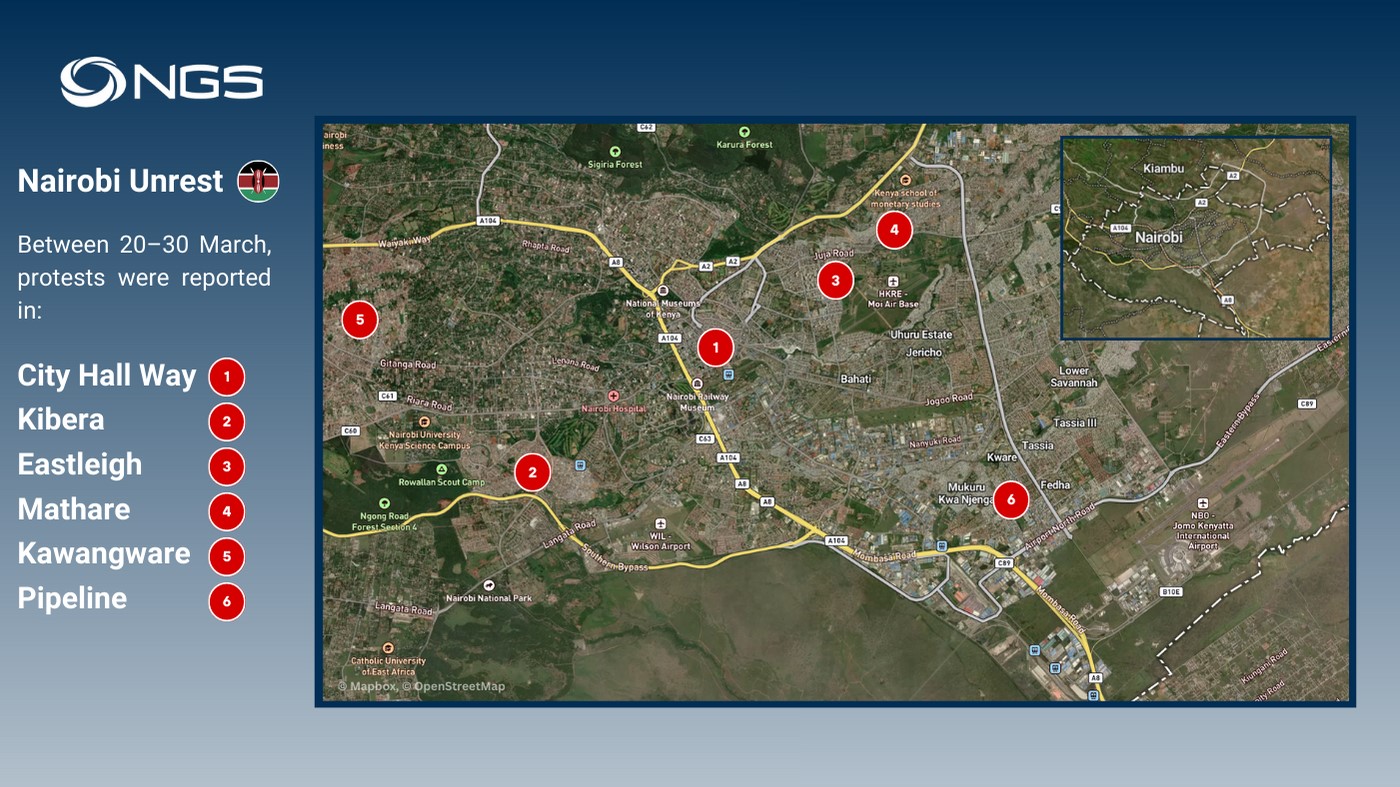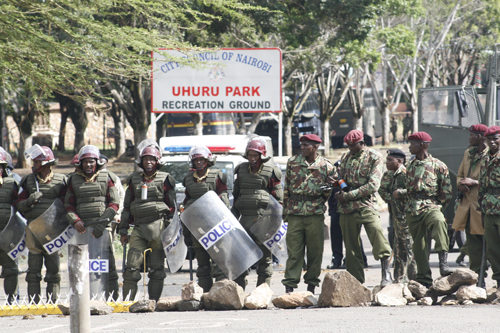Over the last two weeks, towns in western Kenya have experienced a wave of violent protests that have seen at least three deaths and over 400 injuries. Unrest has been spearheaded by Raila Odinga (leader of the opposition), who was narrowly beaten by President William Ruto in the 2022 general election and has claimed the result as illegitimate, despite the Supreme Court and international observers regarding it as fair and credible. The scale of protests has been exacerbated by the cost of living crisis. Odinga has skilfully coalesced the two issues into a single protest movement, which may last for longer than expected.
Reasons Behind Unrest
Odinga has demanded a full audit of the 2022 election. Raila Odinga and his Azimio la Umoja-One Kenya coalition were very narrowly defeated by President William Ruto (less than 2% of the vote share) in the 2022 general election in August 2022. Odinga claimed the result was illegitimate, despite international observers and Kenya’s Supreme Court declaring it fair and credible. Nevertheless, Odinga demands a full audit of the election result.
Odinga has demanded reform of the Independent Electoral and Boundaries Commission. The IEBC acts as the key gatekeeper to regulating all electoral activity. He seeks changes to the process of selecting commissioners. Following a wave of resignations in the wake of the 2022 election, there are currently six vacancies on the commission that still need to be filled. President Ruto has constituted a seven-member selection panel to determine the new commissioners, which Odinga claims will culminate in the appointment of pro-Ruto commissioners predisposed towards Ruto’s United Democratic Alliance party.
Kenya’s perilous economic position. Prices of many essential food products have risen between 20% and 50% in the last year, with maize flour, a Kenyan staple, rising 21.5% in the last ten months. This crisis has been compounded by Kenya’s recent poor harvest and drought. This has led to a heightened dependence on food imports, putting additional pressure on the already struggling Kenyan shilling: the shilling depreciated 9% against the US dollar in 2022 and has slumped a further 6% in Q1 2023. With Kenya’s balance of payments deficit subsequently widening, government debt has ballooned to over 70% of GDP, inhibiting the government’s ability to effectively intervene to alleviate the crisis. The crisis has spiralled to the extent that 5.3 million Kenyan nationals are now believed to be facing starvation.
Raila Odinga has coalesced the two distinct strands of grievances (electoral and economic) into one protest movement, and it remains unclear the extent to which each strand resonates most with protestors. Overall, it is likely that economic grievances are as indispensable a factor (if not more) in motivating the ongoing protests than Odinga’s electoral demands. It is unlikely Odinga would have been able to inspire such a fierce and sustained protest movement on solely electoral reform related grievances, especially given the supreme court has already upheld Ruto’s victory. Instead, given the epicentre of the protests has been amongst Nairobi’s most deprived neighbourhoods, it is likely the cost of living crisis is the key mobilising factor in the protests.
Timeline of the Protests
Since Odinga initially called for protests on Monday 20 March, protests occurred bi-weekly (on Mondays and Thursdays) with the primary focus being in Nairobi, though other urban areas in western Kenya have also experienced unrest.
Monday 20 March: Simultaneous demonstrations took place across Nairobi, including in Kibera, Eastleigh estate, Mathare estate, and City Hall Way. There was also a protest in Kisumu, where one university student was killed by security services who reportedly fired live rounds indiscriminately into the crowd having exhausted their supply of tear gas canisters. Authorities in Nairobi responded similarly sternly: water cannon and tear gas were widely used and over 200 demonstrators were arrested, including four opposition politicians (including Senate minority leader Stewart Madzayo); all four were later released on bail.
Thursday 23 March: Protests erupted in Kibera, Eastleigh estate, and Mathare estate in Nairobi after security services in the city pre-emptively erected barricades to prevent protests from occurring in the central business district. Following the protest, the police issued an indefinite ban on protest activity in Nairobi, citing unspecified “security reasons”.
Monday 27 March: In spite of the police ban, Odinga led another round of protests in Nairobi with Kibera and the Eastleigh estate once again acting as the epicentres, along with Kawangware. Social media footage from the demonstration showed protestors setting fire to several businesses and a church in Kibera. Outside Nairobi, there was also a demonstration in Kisumu which resulted in one protestor being shot by security services. Property belonging to Odinga’s family and a farm owned by former president Uhuru Kenyatta, who supported Odinga in the 2022 election, were also vandalised.
Thursday 30 March: Protests again erupted in Nairobi, this time concentrated in Mathare estate, Kibera, and the Pipeline estate. In Mathare estate, protestors used improvised catapults to launch stones and bricks at security services. Odinga claimed that security services had made an attempt on his life, subsequently posting a video on social media showing dents in his armoured vehicle. Outside Nairobi, protestors set fire to an office of Ruto’s United Democratic Alliance party in the western town of Siaya.
Monday 03 April: Odinga called for a cease in protests after Ruto agreed to bipartisan talks through the medium of parliament to resolve the grievances behind the protests. Specifically, Ruto claimed he is ready to engage with opposition groups on reconstituting the panel to select the incoming IEBC commissioners. This move came after international governments and institutions such as the African Union and the United States Embassy in Nairobi urged Ruto to reconcile with Odinga.

Figure 1: Areas of unrest in Nairobi, March 2023
Outlook
Odinga has warned that if there is “no meaningful engagement or response from Ruto, the protests [will] begin again in one week”. Given Odinga’s demands include an unrealistic request for a full audit of the election, the likelihood of full agreement is low. Therefore, it is likely that there will be at least one further round of protests in Nairobi.
The intense protest zeal ignited by Odinga is unlikely to be immediately quelled at a time of such an acute cost of living crisis. Odinga has skilfully integrated economic concerns into his wider electoral protest movement to bolster its capability. However, given the ferocity of the protests it is possible that even if Odinga’s electoral grievances are met, violent protests relating to the cost of living crisis will persist in Nairobi.
The primary threat to travellers to Kenya stems from being inadvertently entangled in the unrest. This threat is especially pertinent given the brutality and indiscriminate nature of the tactics employed by police, including the use of tear gas, water cannons, and occasionally live fire against protesters. Consequently, any travellers to Nairobi are liable to be inadvertently caught up in the protests.
There is a particular threat to journalists: the Kenya Media Sector Working Group has claimed over 20 journalists and media workers (including for international organisations) have been attacked during the wave of protests, including physical assault, broken equipment, harassment, and arbitrary detention.
Security Advice
–Avoid all protests and restrict travel Kibera, Eastleigh estate, Mathare estate, Kawangware, Pipeline estate,
–Establish pre-arranged itinerary and ensure tracking capability is operable at all stages of travel in Kenya.
–Employ the services of a trusted local fixer for security and transport.
–Establish a staff check-in system to give assurance that travellers are safe throughout.
–Regularly monitor local news and social media to be informed of any upcoming protests
–Comply with any demands made by security services
Author: Edward Bach, Risk Analyst, Northcott Global Solutions
Contact: risk@northcottglobalsolutions.com
Northcott Global Solutions provides risk assessments, tracking, security escorts, personal protective equipment, remote medical assistance and emergency evacuation.
DISCLAIMER:
Material supplied by NGS is provided without guarantees, conditions or warranties regarding its accuracy, and may be out of date at any time. Whilst the content NGS produces is published in good faith, it is under no obligation to update information relating to security reports or advice, and there is no representation as to the accuracy, currency, reliability or completeness. NGS cannot make any accurate warnings or guarantees regarding any likely future conditions or incidents. NGS disclaim, to the fullest extent permitted by law, all liability and responsibility arising from any reliance placed on content and services by any user with respect to acts or omissions made by clients on the basis of information contained within. NGS take no responsibility for any loss or damage incurred by users in connection with our material, including loss of income, revenue, business, profits, contracts, savings, data, goodwill, time, or any other loss or damage of any kind. Image accessed from https://commons.wikimedia.org/w/index.php?search=nairobi+protest&title This file is licensed under the Creative Commons Attribution-Share Alike 4.0 International license.
